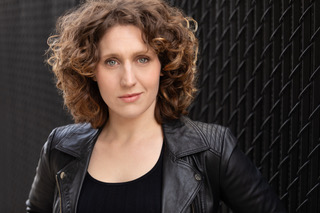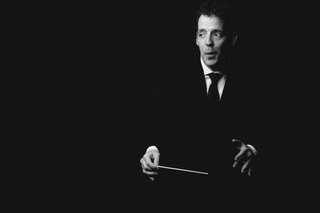Interview: The Sound Between Reimagines Choral Storytelling in Rautavaara's VIGILIA
Sophie Amelkin and Matthew Goinz launch The Sound Between, choral ensemble reimagining musical storytelling, with performance of Rautavaara’s "Vigilia" on 10/25.

A mystical journey through sound and memory awaits audiences in New York City. On October 25, The Sound Between, a newly formed professional ensemble dedicated to immersive musical storytelling, will present Einojuhani Rautavaara’s Vigilia at the Madison Avenue Presbyterian Church. This monumental unaccompanied choral work, inspired by the composer’s transformative visit to Valamo Monastery in 1939, promises to transport listeners to a world of floating islands, ringing bells, and ancient spirituality.
Under the leadership of co-founders Sophie Amelkin (Executive Director) and Matthew Goinz (Artistic Director), The Sound Between aims to “flip the expectations of the traditional choral music performance,” with a focus on narrative. To learn more about this ambitious inaugural performance and the vision behind The Sound Between, we sat down with Amelkin and Goinz.
Could you tell us about your musical background, and current professional activities?
Sophie Amelkin: I started with classical training, which gave me really good musicianship skills such as sight reading. I constantly sought out new learning opportunities, programs, and festivals. I used to record my voice lessons, listen back and take notes, and then apply what I learned in the practice room. My approach to voice was similar to how a violinist would practice violin: I spent hours focusing on things like tongue position and acoustics. As for my current work, I perform in professional choral ensembles in New York City, which often bring me in for specific vocal qualities: for example, they might need a soprano with a particular color in their voice, who can be flexible enough to sing both jazz and classical repertoire. Additionally, I’ve been doing some online work, including lessons for singers through social media platforms. It’s a way for me to share my knowledge and connect with other vocalists.
Matthew Goinz: I was in choir from third grade all the way through high school, where I decided I wanted to pursue music. I went to undergrad for music education and music performance, graduating in 2010. Then I got my master’s degree in conducting at the University of Arizona from 2011 to 2013. After that, I sang with a full-time professional ensemble called Cantus for four years from 2014 to 2018. Then I went to the University of Maryland to get my doctorate in conducting, which I completed in 2022. We moved to NYC shortly after that. Recently, I’ve been doing a lot of music directing, playing keys in pits, and doing more conducting work. I also do a lot of classical singing work throughout the city at major churches.
How do you balance and prioritize your various musical talents and opportunities? Has this approach evolved over time?
MG: As you’re getting your footing, especially in NYC, you can’t be super picky when you first start out. But as you get a bit more established in a city, you can start to really focus on what you love most. Part of the reason why we started The Sound Between is because I want to do a lot more work with conducting, keys, music directing, and arranging.
SA: I would add that the creation of The Sound Between, for us as partners in life and also in business and work, is the culmination of all of those different interests coming together in one. We’ve both done a variety of different things in music in our careers that fill our cup musically.
How did you two meet and connect?
MG: When a mutual friend of ours met me, he immediately wanted Sophie to meet me.
SA: When we did finally meet, we hit it off immediately, because we’re both theater kids, so we just had dorky theater banter. His shirt was tucked in. That impressed me.
MG: It’s always texting, texting, texting when a relationship is first starting. And I would, sometimes right before we’d go to sleep, say, “Okay, while you’re getting ready in the morning, listen to this one.” And I’d give her a different piece of music every night, something that I loved. And so she’d be up at 4:30 AM, listening to what I sent her the night before.
As professional musicians that often travel for work, how do you maintain strong relationships despite the challenges of distance and busy schedules?
SA: Because we both have traveled and toured a lot in our careers, we spend a lot of time apart. But I think it’s very healthy. Absence makes the heart grow fonder, as they say, and it’s a beautiful thing to have somebody to miss. It’s also important to be independent and have things that you do for yourself. It’s never really been an issue.
MG: And after having been in the professional choral circuit, which is kind of where I came up, for 10 to 15 years now, you really make great friends very quickly. You’re intensely rehearsing for like a week at a time, and then you put up your concert three or four times at the end of that week. So it’s a very intense and intimate way to make friends. I’m still in touch with a lot of them. Really, to be a professional musician, you need to be by a big airport, and just keep putting your stuff and yourself out there, and eventually, somebody will bite.

At what point did you decide to take more control of your musical careers by creating your own opportunities, such as teaching and founding The Sound Between, rather than solely relying on traditional gigs?
SA: I think that there are a lot of different paths to being an artist, whether you’re a teaching artist, a conductor, a singer, or whatever it is. And one of those paths is to put yourself in front of others who are in a position to hire you. There was just a certain point where I knew I was never going to give up on doing the things I wanted to do. That epiphany happened a little bit with Matt, because he’s such a phenomenal conductor and musician. He would get to the finals for these big conducting jobs, which is a huge deal, but would maybe miss out on the offer. At a certain point, I said, “Forget it. We’re just going to make the thing.” It’s a lot of work, but it’s worth it. If you go backwards far enough, you realize there was just some person who said, “I want to do this thing,” and started it. And now, years and years on, those are the organizations that all the singers are applying to for young artist programs, hoping to get hired by. I thought, what if we just took the same work ethic we had, and just made the job for ourselves?
Your website highlights choral music as the medium for The Sound Between. How do you see choral music enhancing storytelling compared to solo performances?
SA: Think about going to a Broadway show, opera, or cabaret, and the way that one singular performer can make you feel through expressing their humanity through the song. And imagine now if you took 20 of those brilliant storytelling vocalists, and asked them to weave together their expressivity, uniqueness, and vocal power, and make it into something that’s 20 times as powerful. We’re not thinking of a choir as each soloist diminishing themselves to fit in. For us, choral music is a vehicle to enhance, to multiply exponentially, that connection that an audience can feel to a story and to other humans.
What unique aspects or innovations do you plan to bring to The Sound Between?
MG: The traditional venues like churches are great places to do any kind of music just because acoustically, they’re marvelous. I think the fact that choral works are typically performed in a fairly stationary manner is because people just don’t necessarily have time for staging. But you can kind of stage something, as long as the singers can really hear each other. In the future, w’'re hopeful that we’ll be able to bring The Sound Between to different spaces, other than churches. But for now, this is a great way to get started. We’re excited to use the Madison Avenue Presbyterian Church on October 25, and see what kind of staging we can do in that space.
Could you share the process behind selecting Rautavaara’s Vigilia for your inaugural concert?
MG: We were trying to figure out what to program for this very first concert. And one day I just remembered that I knew this amazing, incredible piece that is Rautavaara’s Vigilia. It’s a dark, evocative, contemporary piece completed in its current form in 1996.

What range of choral music do you envision The Sound Between performing in the future?
SA: We were looking for the perfect piece that would show who we are and what we’re about as an organization. As we grow into an organization that has a generous amount of funding, a perfect season would be inclusive of a variety of things: some works that are maybe more traditional but done in interesting ways, like requiems and operatic repertoire, alongside contemporary commissions. We’re definitely not genre-specific.
Beyond attending the concert, what are the most effective ways for supporters to contribute to The Sound Between’s mission and growth?
SA: The best thing that people could do is come to the concert. Experience it. Take it in …
MG: And also contribute to the cause. The music is for the audience to receive and connect with the artists. So it’s all about building that audience base, connecting with them, and then hoping that they feel excited and connected enough to eventually support us. We are lucky to have some generous support from donors; grant funding is also on our horizon.
After your show at 54 Below, you had a meet-and-greet, and my friend said they’d never been to a concert where singers had this after-party to really talk to the fans. Are you planning something similar for The Sound Between concert?
MG: Yeah, we’ll definitely do something similar after The Sound Between, have a space where people can come and hang out and meet the artists and just talk about the concert.
Tickets to Vigilia and more information about The Sound Between are available on their website here: https://www.tsbensemble.org/performances-and-events/rautavaara-vigilia
Comments

Videos

